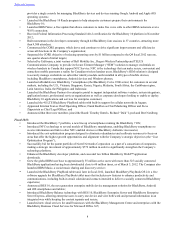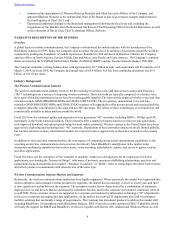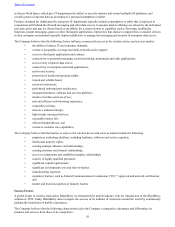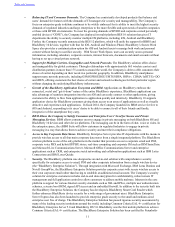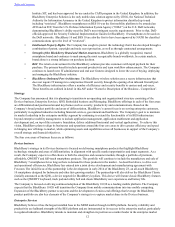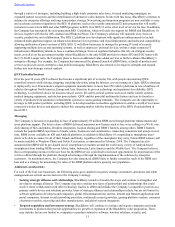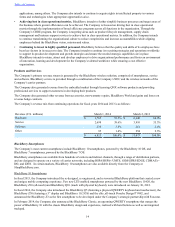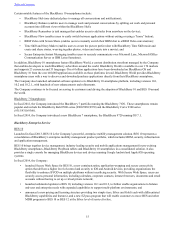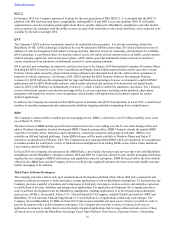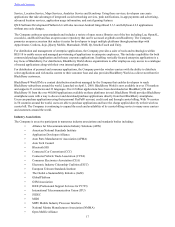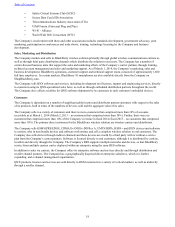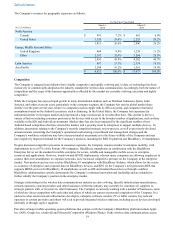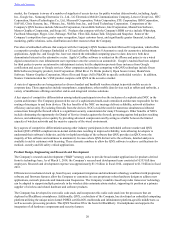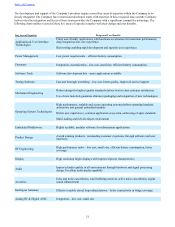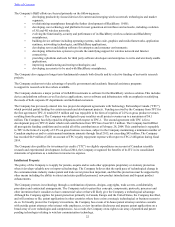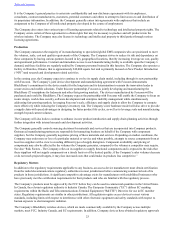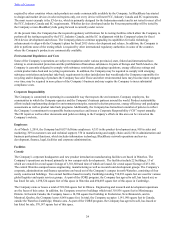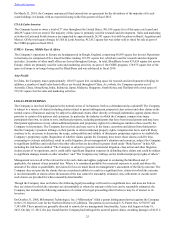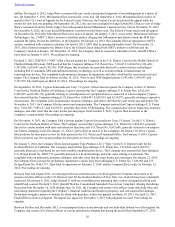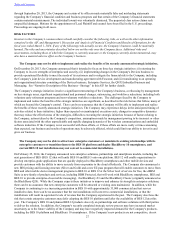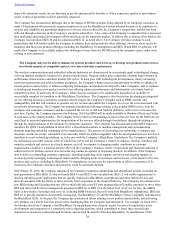Blackberry 2014 Annual Report Download - page 26
Download and view the complete annual report
Please find page 26 of the 2014 Blackberry annual report below. You can navigate through the pages in the report by either clicking on the pages listed below, or by using the keyword search tool below to find specific information within the annual report.
18
• Safety-Critical Systems Club (SCSC)
• Secure Data Card (SD) Association
• Telecommunications Industry Association (TIA)
• UPnP Forum (Universal Plug and Play)
• Wi-Fi – Alliance
• World Wide Web Consortium (W3C)
The Company’s involvement with these and other associations includes standards development, government advocacy, joint
marketing, participation in conferences and trade shows, training, technology licensing by the Company and business
development.
Sales, Marketing and Distribution
The Company markets and sells its BlackBerry wireless solution primarily through global wireless communications carriers as
well as through third party distribution channels which distribute the solution to end users. The Company has a number of
carrier-focused business units that support the sales and marketing efforts of the Company’s carrier partners through training,
technical account management and sales and marketing support. As of March 1, 2014, the Company’s marketing, sales and
business development, BlackBerry operations, customer support and technical support teams consisted of approximately 1,600
full time employees. In certain markets, BlackBerry 10 smartphones are also available directly from the Company on
ShopBlackBerry.com.
The Company sells QNX software and services, including development tool licenses, support and engineering services, directly
to customers using its QNX-specialized sales force, as well as through embedded distribution partners throughout the world.
The Company also collects royalties for QNX software shipments by its customers in such customers' embedded devices.
Customers
The Company is dependent on a number of significant global carrier and distributor partner customers with respect to the sales
of its products, both in terms of the numbers of devices sold and the aggregate value of its sales.
The Company sells to a variety of customers and there were no customers that comprised more than 10% of accounts
receivable as at March 1, 2014 (March 2, 2013 – no customers that comprised more than 10%). Further, there were no
customers that comprised more than 10% of the Company’s revenue in fiscal 2014 (fiscal 2013 – no customers that comprised
more than 10%). The primary direct customers for the BlackBerry wireless solution are wireless carriers and distributors.
The Company sells GSM/GPRS/EDGE, CDMA/Ev-DO/Ev-DO Rev A, UMTS/HSPA, HSPA+ and iDEN devices and software
to carriers, who in turn bundle devices and software with airtime and sell a complete wireless solution to end customers. The
Company also sells devices through indirect channels and these devices are resold by a third party with or without a service
plan from the Company’s carrier partners. Software is licensed directly to end customers, although it is distributed by carriers,
resellers and directly through the Company. The Company’s BES supports multiple networks and devices, so that BlackBerry
service from multiple carriers can be deployed within an enterprise using the same BES software.
In addition to sales via carriers, the Company offers its enterprise software and services directly and through distribution and
reseller channel partners. The Company has a geographically dispersed direct enterprise salesforce, which it is further
expanding, and a channel management organization.
QNX products, licenses and services are sold directly to OEM customers in a variety of vertical markets, as well as indirectly
through a reseller channel.
Table of Contents


